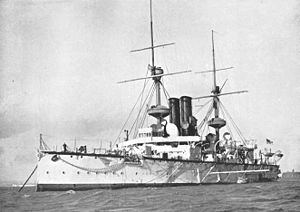Centurion-class battleship
 HMS Centurion
| |
| Class overview | |
|---|---|
| Name | Centurion-class battleship |
| Builders | Chatham Dockyard, Portsmouth Dockyard, Pembroke Dockyard |
| Preceded by | Royal Sovereign class |
| Succeeded by | HMS Renown |
| Built | 1890–97 |
| In commission | 1894–1913 |
| Completed | 2 |
| Scrapped | 2 |
| General characteristics (as built)[1] | |
| Type | Pre-dreadnought battleship |
| Displacement | 10,500 tons |
| Length | 360 ft (109.7 m) (between perpendiculars) |
| Beam | 70 ft (21.3 m) |
| Draught | 25 ft 6 in (7.8 m) |
| Speed | 17 knots (31 km/h; 20 mph) (natural draft), 18.5 knots (34.3 km/h; 21.3 mph) (forced draft) |
| Endurance | 6,000 nmi (11,000 km) at 10 kn (19 km/h) |
| Complement | 620 |
| Armament |
|
| Armour | |
The Centurion-class battleships were second-class pre-dreadnought battleships built for the Royal Navy in the 1890s. They were designed for service on distant stations.
Description

The Centurion class comprised two ships, Centurion and Barfleur. The ships were designed by Sir William White to be lightly armed battleships designed for service on the China Station and Pacific Station. Their relative lack of firepower enabled greater quantities of coal to be carried, extending their range, and it was not thought they would face the big guns of an enemy fleet. They were too lightly armed to slug it out with enemy battleships, but they could outrun them, and they were more than capable of dealing with armored cruisers that they were far more likely to meet on distant stations.[1]
They were considered good steamers and good seaboats, although the use of forced draft was discontinued because it damaged their boilers. Their draughts were designed to be shallow enough to allow passage through the Suez Canal and the navigation of rivers in China. Their hulls were sheathed with wood and copper to reduce fouling and hence allow them to sail longer between docking.[1]
The ships were armed with four 10 inch (254 mm) guns in two barbettes covered by open-backed armored hoods and capable of all-around loading, a secondary armament of ten 4.7 inch (120 mm) guns, numerous smaller guns, and seven torpedo tubes. The previous Royal Sovereign-class battleships had allowed a comparison between high-freeboard ships with their main guns in open barbettes and low-freeboard ships equipped with old-style, heavy, circular turrets and had proven the superiority of the former in the rough waters of the Atlantic; the Centurions were the first barbette-type battleships with armored hoods over their barbettes, giving rise to the armored gunhouses that would be mounted on later ships and which themselves would come to be known as "turrets."
Centurion in 1901–1903 and Barfleur in 1902–1904 underwent a reconstruction in which their 4.7 inch (120 mm) guns were replaced by 6 inch (152 mm) guns in armored casemates, the additional weight being compensated for by reductions in their masts and the removal of all five of their above-water torpedo tubes. They were slightly slower, at about 16.75 knots (31.02 km/h), after these refits.[1]
Like all pre-dreadnoughts, the Centurions were completely outclassed by the new dreadnought battleships that began to appear in 1906, and were scrapped a few years later after a period in reserve.
Ships in Class
HMS Centurion
HMS Centurion was launched in 1892 and completed in 1894. She served on the China Station as its flagship (1894–1901), served there again (1903–1905), then served in the Reserve Fleet (1905–1907) and Home Fleet (1907–1909) before being scrapped in 1910.[2]
HMS Barfleur
HMS Barfleur was launched in 1892 and completed in 1894. She served in the commissioned reserve (1894–1895), Mediterranean Fleet (1895–1898), China Station (1898–1901), Reserve Fleet (1904–1906), and Home Fleet (1907–1909) before being scrapped in 1910.[2]
Notes
References
- Burt, R. A. (1988). British Battleships 1889–1904. Annapolis, Maryland: Naval Institute Press. ISBN 0-87021-061-0.
- Chesneau, Roger; Koleśnik, Eugène M.; Campbell, N.J.M. (1979). Conway's All the World's Fighting Ships, 1860–1905. London: Conway Maritime Press. ISBN 0-85177-133-5.
{{cite book}}: Invalid|ref=harv(help) - Friedman, Norman (2011). Naval Weapons of World War One. Barnsley, South Yorkshire, UK: Seaforth. ISBN 978-1-84832-100-7.
- Gibbons, Tony. The Complete Encyclopedia of Battleships and Battlecruisers: A Technical Directory of All the World's Capital Ships From 1860 to the Present Day. London: Salamander Books Ltd., 1983.
- Gray, Randal, Ed. Conway's All The World's Fighting Ships 1906–1921. Annapolis, Maryland: Naval Institute Press, 1985. ISBN 0-87021-907-3.
- Parkes, Oscar (1990). British Battleships (reprint of the 1957 ed.). Annapolis, Maryland: Naval Institute Press. ISBN 1-55750-075-4.
